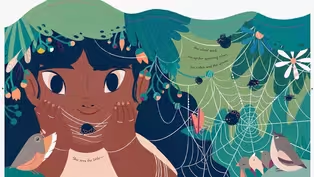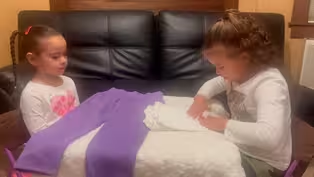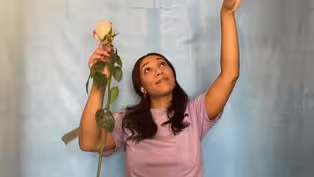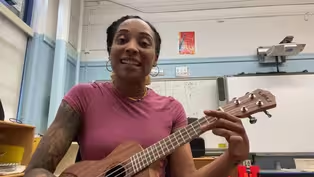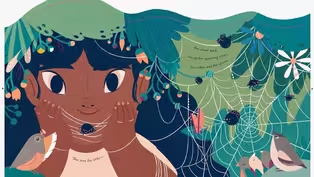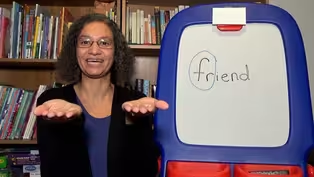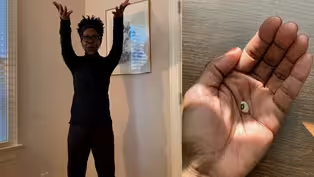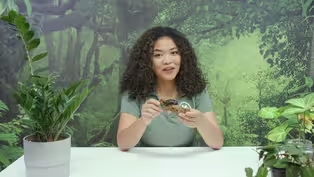
Do You Hear the “fr” Blend in Friend?
4/20/2023 | 56m 56sVideo has Audio Description, Closed Captions
LET’S LEARN about plants! Find out how animals & plants need each other.
LET’S LEARN about plants! Use math to water plants and measure their growth. Find out how animals and plants need each other. Pretend to be a flower. Hear music grow louder. Read MY FRIEND EARTH and words with fr blends. One-hour programs help children ages 3-7 learn in school and at home. Content provided by Education Through Music and NYC Children’s Theater.
See all videos with Audio DescriptionADProblems playing video? | Closed Captioning Feedback
Problems playing video? | Closed Captioning Feedback
Let's Learn is a local public television program presented by THIRTEEN PBS

Do You Hear the “fr” Blend in Friend?
4/20/2023 | 56m 56sVideo has Audio Description, Closed Captions
LET’S LEARN about plants! Use math to water plants and measure their growth. Find out how animals and plants need each other. Pretend to be a flower. Hear music grow louder. Read MY FRIEND EARTH and words with fr blends. One-hour programs help children ages 3-7 learn in school and at home. Content provided by Education Through Music and NYC Children’s Theater.
See all videos with Audio DescriptionADProblems playing video? | Closed Captioning Feedback
How to Watch Let's Learn
Let's Learn is available to stream on pbs.org and the free PBS App, available on iPhone, Apple TV, Android TV, Android smartphones, Amazon Fire TV, Amazon Fire Tablet, Roku, Samsung Smart TV, and Vizio.
Providing Support for PBS.org
Learn Moreabout PBS online sponsorship- [Narrator] Ready to learn?
[playful music] - Hi.
- Hi, friends.
- [Narrator] It's time to share a story, read and write.
- Let's take it from the beginning.
- [Narrator] Discover science, sing.
♪ Hello, friends ♪ - [Narrator] Play.
And so much more.
- We're exploring with light.
- [Narrator] Stay tuned for lessons and activities.
- And the keyword is?
- Apple.
- Awesome.
[playful music] - [Narrator] Funding for this program was provided by the JPB Foundation.
- Hi friends, my name is Carlton and today I am so, so excited to be with each and every one of you.
And today we are gonna read a very fun book.
I'm so excited.
And the name of the book is called "My Friend Earth."
It's written by Patricia MacLachlan, and the illustrator is Francesca Sanna.
Shh.
I think she's taking a nap.
You gotta be quiet.
My friend Earth wakes from a winter nap.
She hears the busy spring sounds.
The farmer's hoe tap-tapping in the garden, the caws of crows.
She sees the little.
The silent seed, the spider spinning silver, the robin and the wrens.
And the large, the long winged albatross crossing the sea, the mole tunneling in the under dark.
She guides a chimpanzees to her night nest and the zebra baby to find his mother in the hundreds of black and white striped mothers.
Friends, where did she go?
Oh, I see her.
She's all the way in the back.
She tends the prairie where the sun dappled wild horses run through the grass that swooshed against their legs.
The tundra where the reindeer graze for moss and the glistening ice where the young polar bear pads on mitten feet.
It looks like we're going into the ocean.
Are you ready?
Let's go.
She guards all the creatures in all the oceans.
The black manta race, sleek like shadows, the shining parrotfish, the tiny krill who swim with millions of other krill to look big.
And the whales who are big.
My friend Earth pours the summer rain to fill streams, flowing down mountains, through the fields, to the rivers, to the sea.
Sometimes she pours too much rain, flooding towns and meadows and roads until she dries the land.
And uh-oh, it looks like the mountains are covered with rain.
Sometimes she blows fierce autumn winds sweeping the limbs of trees and shingles from the roofs of the barns until she sails the wind.
So red and orange yellow leaves float on the ground.
Friends, do you know what season this is?
This is the fall season, which is one of my favorite, favorite seasons.
When cold comes again, my friend Earth sprinkles the snow, whisper silent, covering the dens where the baby black bears are born in soft darkness, drifting over the icy pond where the turtle sleeps in mud, settling into the empty nest of birds.
Under the white, the silent sea is cradled in the dark soil watching.
Friends, what kind of animals do you see in this picture?
I see a bear.
I see a fox.
I see a squirrel.
What else do you see?
Great job.
Let's keep going.
Waiting to fly up again in the warm, bright sun of spring.
Okay, friends, wasn't that a great story?
I think so myself.
Now I have an activity for us.
I want you to look out your window and tell me, what do you see?
What do you see out your window?
Do you see a bird, a building?
Do you see trees?
What's the weather like?
Okay, now once you do that, let's draw what we see.
Okay, so I have, out my window, I have a large tree, and the the trees are changing colors, so that's what I'm gonna draw.
Okay, friends, I have a brown crayon, a red crayon, an orange crayon, a green crayon and a yellow crayon.
First, I'm gonna draw the trunk of the tree.
Remember, I see a large tree outside of my house, right outside my window.
Now I need to color in the leaves.
Some of the leaves are red.
You got a lot of different red.
Some of them are falling, some of them are already on the ground.
Next, I'm gonna color in the orange leaves.
Friends, what is your favorite color, by the way?
Well, actually, my favorite color is orange.
So I'm having a lot of fun right now doing this.
All right, some of the leaves haven't changed colors.
Some of them are still still green.
So I'm gonna color in the green leaves and some of the leaves are turning yellow.
So let's fill in the the yellow leaves.
And look, friends, we have a tree that has multiple colors on the leaves.
So, oh, we can't forget about the sun.
And there you have it, friends.
This is what I see outside of my window, a tree with different colors.
Some of the leaves are falling, some of the leaves are are different colors.
But this is what I see.
What do you see?
Can you draw it?
You guys are awesome.
Thank you so much for spending time with me.
I cannot wait to spend time with you again.
All right, bye-bye.
[playful music] - Oh, hi, friend.
My name is Anna.
I was actually just texting a friend of mine to see if she wanted to meet up with me in a little bit at the mall.
Who are some of your friends and what are the things you would like to do with them?
Aw, that's really cool.
Yeah, I like doing things outdoors too, like riding bikes and playing games.
Well, actually, the word friend has our focus in that word.
Let me write the word here.
So in the word friend, we have these two letters.
Those are called blends.
Can you say blends?
Good.
So blends are when two or three consonants are put together, but they keep their individual sounds.
So we're gonna learn about them today.
Does that sound like fun?
Great, all right.
Before we do that though, let's get our ears ready to work with some sounds like we always do.
Let's blend some onset and rhyme.
I'm gonna give you the first part of the word, then I'll give you the second part of the word.
So onset rhyme, and then you're gonna blend it together to tell me what the whole word is, okay?
So listen to this example.
If I said bl and then ak.
Bl, ak.
Put it together, black.
All right, how about this?
Fl, at.
Flat.
Pl, ate.
Plate.
Br, ick.
Brick.
Sl, ept.
Slept, okay.
Blends are two or three consonants put together, but they keep their individual sounds.
So first, let's figure out which letters are the consonants.
Sometimes it's easier to think of the vowels first.
Which letters represent vowels?
That's right.
A,E,I,O, and U.
So the remaining letters of the alphabet would be our consonants.
So my favorite blend is actually this one.
Three letters that say scr, like scratch or screech, or like in my last name, scratching.
So that's my favorite blend.
Today we're gonna focus on two letter blends, okay?
We're gonna focus first on S blends, and then we're gonna focus on some R blends, okay?
So if I have my S, what sound does I represent?
Right.
And if I pair it with where this letter, what sounds does it make, does that letter represent?
Right, "l." So we have ss, il, let's blend it together.
Sl, right.
Like in the word, slip, right.
Don't slip on the ice.
Okay.
How about, we'll keep that sl, 'cause we're working on our S blend.
And then we have, this letter.
What sound?
That's right, T. So s, t. If we blend it, it becomes st. Like in the word stop.
Okay, how about this last one?
What's this letter?
Think of the sound it represents.
Right, p. So we have s, p. And we blend it, sp Like in the word spot, okay?
Did you notice something really cool about all of these S blends?
We had SL, we had ST and now we have SP.
You notice how for the most part, our S is gonna stay in that first space when we're writing our blends.
So sl, st, sp, okay?
Let's do some blends now with the letter R. Okay.
So I'm gonna have my R right here.
Now, what sound does R represent?
That's right, er.
Okay, so now if I were to put this.
We have b, r, br.
Like brag, right?
He likes to brag about how good he is at playing sports.
Okay?
Brag.
What if we do this instead?
So what sound?
That's right, G represents that g sound.
So we have g, er, gr.
Okay, and that's kinda like the word grip, right?
Make sure you grip your pencil correctly when you are writing, grip.
Okay, let's try one more.
How about, so what's the sound?
Okay, we have f, r, let's blend it.
Fr.
Like the word free.
Now, what did you notice about these blends?
Okay, so we had br.
We had gr.
And we have fr.
This time you noticed that R was within that second stop, right?
Because we're not gonna see blends where R is going to be the first letter, okay?
You're not gonna see that.
R will not be in that first position, okay?
Do you think you're ready to try to write some words with these blends?
Okay, go get a piece of paper and a pencil and meet me back here, go.
[upbeat music] Come here, come close.
So there's actually two R blends that can be a little bit tricky that I wanna teach you about.
Is that okay?
All right.
It's TR and DR.
So a lot of times when TR is used at the beginning of the word, it actually sounds like like chr.
Like train.
But it's spelled with a TR, just like the word trick.
So sometimes when you hear chr, it's actually gonna be spelled TR, so pay attention to that.
The other one is DR.
So a lot of times it sounds like you're hearing jr, but you're not gonna see J and R next to each other.
That's not a blend.
So when you hear J, it's usually going to be DR, like in the word dress or drink, okay?
Don't let those tricky R blends fool you.
Hopefully you have the material you need and it's not, it's okay.
You can still just follow along with us.
So what's gonna happen is I am giving you the rhyme or the ending part to a whole bunch of words.
You are responsible for coming up with the S or R blend that appears at the beginning of the word, okay?
So remember we're either gonna have S and a consonant or some sort of consonant with the R. Let's look at the first word, listen carefully.
The word is slop, so if we need to, let's stretch it.
Slop.
What do we hear at the beginning of the word?
What blend?
Slop.
Right.
So I hear, sl in slop.
All right, how about the next one?
The word is brick.
What blend do you hear in the word brick?
Brick.
Brick.
So are we gonna be using our S blend or our R blend?
That's right, it's an R blend, right?
So what letters do we need for brick?
That's right, we need BR for that br, brick.
Okay, how about the next word?
The next word is small.
Are we using S blend or R blend?
That's right, it's an S blend.
Okay, so how are we writing small?
Okay, so we know we're gonna start with that ss.
And then we need mm, our M for small.
All right, how about this word?
The word is tree.
Tree.
Is that an S blend or R blend?
That is an R blend.
Okay, so how are we gonna spell tree?
That's right, tr, ee.
Tree.
All right, last word.
How about the word frown?
Ooh, frown.
Is that an S blend or an R blend?
That's right, it's an R blend.
Okay, so how are we gonna make fr at the beginning of frown?
If you put fr you are correct, give your brain a kiss.
Thank you so much for working on your blends with me.
So today we focused on our S blends and our R blends.
As you're reading, see if you can find some words with either S or R blends in them.
Well, until next time, friends.
Bye.
[playful music] - Hi, my name's Bella.
- Hi, my name is Lulu.
- And we know have a fold clothes.
Wanna see?
- First we're gonna start with a shirt.
We're gonna bring the sleeve to the middle and do the same thing with the other sleeve.
We're gonna bring the bottom up to the sleeve and we are done.
- I'm gonna do a pair of pants.
First, I fold it halfway and then I fold the bottom halfway.
I do it one more time.
- And that is how we fold clothes, bye.
[playful music] - Oh hey, come on in, come on in.
I was just about to take care of my plant, Priscilla.
So this is Priscilla and I've had her for a little while and how I take care of her, I've been giving her every week, I've been giving her three of these small cups of water.
One, two, three.
You wanna water her with me?
Come on.
Look, it's easy.
So here's one and two, and three.
And so I give her three cups of water.
So I've had Priscilla for a little while now and I've had her by this window so she gets lots of light and I've been giving her water every week and she's been growing a lot.
So I also her measure her.
I measure to see how tall she's getting, to see how much she's growing.
So the way I do that, you can use anything that you have at home to measure.
They just have to be all the same size.
So I have a lot of these boxes in my kitchen.
So I use these boxes.
So what I do, I'm gonna stack the boxes up next to Priscilla and I'm gonna stack them up until they're, that they're both at the same height as Priscilla.
So here's, let me do this.
It might take a little while 'cause I've I've gotta watch it carefully.
What do you think?
Are these the same height?
I think I might be able to do one more box, let's see.
What about now?
I think that's about right.
I think that's about right.
So now all I have to do is count the number of boxes and that'll tell me how tall Priscilla is.
So Priscilla is one, two, three, she is three boxes tall.
So this week she's three boxes tall.
But I'm going to, when I water her next week, I'm gonna measure again.
What do you think?
Do you think she's gonna be three boxes tall?
Do you think she's gonna be more?
What do you think?
What do you think, we're gonna find out next week.
Oh, you're still here.
This is great.
I just learned this wonderful finger play about a little seed.
Can I teach it to you?
Great, awesome.
You're gonna follow along with me.
First we're gonna start, we're gonna be crouched down low 'cause we are a little seed, so follow after me.
Here's one little seed in the dark, dark ground.
Out come comes the sun, yellow, and round.
Down comes the rain, wet and slow.
Up comes the little seed, to grow, grow, grow.
Here are two little seeds in the dark, dark ground.
Out comes the sun, yellow and brown.
Down comes the rain, wet and slow.
Up comes the little seed, grow, grow, grow.
Here are three little seeds in the dark, dark ground.
Up comes the sun, yellow and round.
Down comes the rain, wet and slow.
Up comes the little seed, grow, grow, grow.
Here are four little seeds in the dark, dark ground.
Up comes the sun, yellow and round.
Down comes the rain, wet and slow.
Up comes the little seeds.
Grow, grow, grow.
Here are five little seeds in the dark, dark ground.
Up come the sun, yellow and round.
Down comes the rain, wet and slow.
Up come the little seeds, grow, grow, grow.
That was fun, right?
So did you notice what happened to the little seeds?
Yeah, they grew and grew and grew.
Do you remember what seeds need to grow?
Yeah, light and water.
But where did the little seeds get light and water from?
Oh yeah, they got light from the sun and water from the rain.
You are so smart.
Thank you so much for playing with me today.
I had so much fun.
Did you?
I'll see you next time.
Bye.
- My name is Doris, my husband David and I, we have two children, Dalia and Daniel.
Okay, go for it.
Our hope for our children is that they are happy, confident, and caring so that they can thrive in school and in life.
When I became a mother, it was very important for my children to be able to name and express their feelings so that they can better deal with their emotions.
Remember these?
When my children were very young, we started using picture books as tools to identify emotions within characters.
Sometimes I'll ask them questions to help them begin to identify their feelings for themselves.
I see a sad face.
Is that right?
- Hmm-mm.
- [Doris] If they can connect to their own feelings, then they can connect to others feelings.
We make time daily to ask questions and practice listening.
- How was your day, daddy?
- Oh, my day was amazing, Danny.
- And I think it just really shows 'em how to be a good friend and the importance of thinking of others.
- Congratulations, Daniel.
- Tapping into feelings has helped my children with confidence and self-awareness.
At school, they know how to manage feelings as they come up so that they can focus on learning.
- So have a good day in school, okay?
[lively music] - Hi friends.
My name is Chelsea and I'm an animal interpreter at the Memphis Zoo in Memphis, Tennessee.
Here at the zoo, I get to take care of some incredible animals and share some of the things that I'm passionate about with friends like you.
Today, we're going to explore one of my favorite topics, plants.
As a zookeeper, I talk a lot about animals, but it's just as important to me that I tell the stories of plants too.
They can live in a wide variety of conditions, respond to their environment by altering the way that they grow and even have special methods for communicating with other plants and animals.
Plants are an essential part of life on earth.
Plants provide people with food, shelter, clothes, medicine and even the oxygen that we breathe.
But you and I are not the only ones that rely on plants.
Animals also need plants to survive and thrive.
Let's learn about the remarkable ways in which animals and plants help each other and in doing so, learn how we can help plants too.
The lives of plants and animals are intricately woven together.
Plants are impacting animals in countless ways all the time.
But the two most fundamental services that plants provide to animals are food and shelter.
Food provides the energy that living things need to operate, and plants are a crucial food source in the animal world.
Herbivores are animals that only eat plant matter.
Deer, elephants and gorillas are all herbivores.
Herbivores can eat grasses, leaves and even wood.
Some herbivores only can consume specific parts of plants like frugivores.
Frugivores are animals that primarily eat fruit.
Like Lilo, the keel-billed toucan.
Lilo gets a wide variety of fruits every single day.
If you asked her to imagine a world without plants, she'd say no way.
Other herbivores are specialists, meaning they have adapted to eating one specific plant.
The koala in Australia only eats the leaves of the eucalyptus tree and the giant panda of Asia feeds strictly on bamboo.
Plants also provide animals less shelter.
A shelter can be a place of security where animals find protection from predators, a place to find or store food, a place to raise their young, a place to sleep, or even just a place to rest.
Plants like trees often make great homes for animals.
Our boreal animals are animals that spend most their time in trees, finding shelter and hollow cavities that are up high in the branches.
Check out this monkey, our boreal animal enjoying the shelter of a tree, being able to retreat into trees keeps our boreal animals safe from predators on the ground that might not be able to reach them.
It also makes it easier for them to watch for danger from a high vantage point, this is perfect for animals like birds who use trees as shelter to build nests for their babies.
The babies will stay up in those nests until they're big and strong enough to take care of themselves.
Plants like tall grasses provide shelter in the form of cover for animals hoping to stay hidden from predators.
Although these tall grasses may also help predators stay hidden while hunted.
The stripes on a tiger's fur for example, are specially adapted to help tigers blend into the tall grass in which they live.
Kelp forests underwater provide the structure for a balanced and flourishing ecosystem where many animals can find shelter and a home.
Wow, plants help animals in so many different ways, but don't you worry, animals do their fair share of helping too.
Animals and plants help each other out through mutualistic relationships.
A mutualistic relationship is a special partnership between two species in which both benefit from one another.
Let's explore how animals help plants through some of these unique partnerships.
First, animals help plants with pollination.
In order for many plants to reproduce and make more plants, they must undergo pollination.
Animals like these butterflies and hummingbirds are crucial for helping plants pollinate.
These animals enjoy drinking the yummy nectar from flowers.
And when they stop to get a drink, the sticky pollen from the flower will get stuck to their leg or another body part.
The pollen will hitch a ride on that animal until it is brought to the animal's next nectar stop where the pollen will fall off and fertilize that plant.
The animal gets a meal and the plant gets to reproduce.
Both parties benefit.
Plants have adapted methods to attract more pollinators to them, such as sporting bright, beautiful flowers.
This is enticing to animals like bees that are drawn to bright colors.
Some plants may emit a special smell to attract their preferred pollinator, or they may even have certain barriers to deter the unpreferred pollinators.
Not all pollinators in the animal kingdom fly.
The Madagascar hissing cockroach like Buddy here is one of my favorite pollinators to talk about.
These friends are native to Madagascar, an island off the coast of Africa, and they are an important pollinator for the cacao plant, which is responsible for producing chocolate.
I don't know about y'all at home, but I love chocolate.
And in addition to chocolate, there are many foods that the world wouldn't have without successful pollination, including fruits, vegetables, and nuts.
So we have a lot of gratitude to express to Buddy and his pollinating friends.
Second, animals help plants with seed dispersal.
Like pollination, seed dispersal is a crucial process for the growth of new plants.
Seed dispersal occurs when the seeds of a plant travel away from it and settle somewhere where they can grow into a new adult plant.
Wind, water and even humans can help seeds disperse, but animals are a huge help.
Animals disperse seeds in two main ways, excretion and burying.
Let's talk about excretion.
When an animal eats fruit, it usually consumes the seeds as well.
Well, when that animal travels to another place, the seeds they ate are also expelled or excreted by hitching a ride in the animal's poop, the seeds will hopefully take well to the new location they've been dropped in and grow into adult plants.
Animals don't only use the power of poop to disperse seeds though, they can bury them.
Squirrels like [indistinct] the Western Gray Squirrel love eating nuts and seeds.
Squirrels often like to store some of the nuts they collect so they can come back to them later and eat them.
They do this by burying them in the ground.
Pat, pat, pat, all hidden and covered.
Well, it's pretty common for the squirrels to forget where they buried some of these nuts.
And so the nuts that the squirrels have planted and forgotten about may grow to become adult plants.
Kind of like little gardeners.
Who knew animals help plants in so many ways, but you might be wondering, how could we help plants?
We can create mutualistic relationships with plants too.
Let's look at three main ways that we can help.
The first thing that we can do to help plants is to use less paper products.
We can use towels instead of paper towels.
Reuse paper for fun crafts and use both sides of a sheet of paper when we're writing, or if possible, opt for a digital option like a computer or a laptop.
The less paper that we use, the less trees that have to be cut down to make paper products.
The second way that we can help plants is by being kind to them.
Plants are incredibly in tune with their environment and the stimulus around them.
Knowing this, we can take extra care to give plants their space and be respectful.
Observing the beauty of flowers instead of plucking them from the ground and staying on designated pathways when possible to avoid stepping on fragile plants that may be nearby.
Continuing to learn about plants gives us knowledge and knowledge gives us the power to ensure that we do our part and making earth a place where plants can thrive.
All right, friends, how about we review what we learned?
First, we learned how plants help animals with food and shelter.
Then we learned how animals help plants with pollination, seed dispersal and protection.
And finally, we learned how we can help plants by doing things like using fewer paper products and giving plants their space.
Now, I want you to close your eyes and imagine all the things in your life that you could thank a plant for.
Now, open your eyes.
It's a lot, right?
Well, now you know how to thank them.
Friends, I hate to have to leaf, but it's time for me to give back to the animals.
Thank you so much for exploring the world of plants with me.
And on behalf of myself and the rest of us here at the Memphis Zoo, may you continue learning and making a difference.
I'm rooting for you.
Okay, last one, I promise.
Bye, friends.
[lively music] - My name is Doris.
[speaking in foreign language] [kids cheering] - Remember these?
[speaking in foreign language] I see a sad face.
Is that right?
- Hmm-mm.
[speaking in foreign language] - How was your day, daddy?
- Oh, my day was amazing, Danny.
[speaking in foreign language] So have a good day in school, okay?
[lively music] - Hello, everyone.
My name is Caitlyn McCain and I'm a teaching artist with New York City Children's Theater.
Today we're going to use our voices, bodies and imaginations to do a theater activity together.
Are you ready?
Let's go.
Have you ever seen a flower before?
What did it look like?
Maybe it had a green stem like this and bright colored petals like this, and maybe even some leaves like this.
So now you know what a flower looks like, but have you ever asked a flower how it's feeling?
Today we're going to explore different types of flowers and imagine how they might be feeling using our body, voice and imagination.
Let's get started.
Let's look closer at this flower.
What color is this flower?
That's right, yellow.
I wonder how this yellow flower is feeling.
I see, this flower is yellow and it has lots of small, thin petals that look like they're full of energy.
So maybe this flower is feeling excited because it's the first day of summer.
What does your body look like when it's feeling excited?
My body looks like this when it's feeling excited.
Now, what if this flower could move based on how it's feeling?
If the flower is feeling excited, how might this flower move?
Maybe it would reach its petals up towards the sky like this.
Can you show me how your excited yellow flower moves?
Awesome.
Okay, one more step.
Now that our flowers are feeling and moving, can you imagine what sound this excited flower might make to match its feeling?
Maybe the excited flower is giggling with excitement because the sun is tickling its leaves.
Can you make that sound with me?
[giggles] What sound does your excited flower make?
Will you show me?
Wonderful.
You can make your sounds with your voice or another part of your body too.
Nice.
Last but not least, let's turn our feeling flowers into a garden of feeling flowers.
On the count of three, I want us all to do our excited yellow flower moves and make our excited yellow flower sounds together just like a patch of flowers in the garden.
Ready?
One, two, three, action.
[giggling] One more time.
[giggling] Wonderful.
All right, now let's explore a different flower.
What color is this flower?
That's right, orange.
How do you think this flower might be feeling?
I noticed that this flower is all alone and it's closed up because it hasn't bloomed yet like it's friends.
So maybe it's feeling a little lonely.
Can you show me what your body looks like when it's feeling lonely like this flower?
My body looks like this when it's feeling lonely.
If this flower is feeling lonely, how might this flower move?
Maybe this lonely flower would sway side to side looking for a blossoming flower friend.
Can you show me with your body how this orange, lonely flower might move?
And now, can you add a lonely sound to your flower?
Maybe sigh like this.
What sound does your lonely orange flower make?
Okay, it's time to turn our feeling flowers into a garden.
On the count of three, I want us all to do our lonely flower moves and make our lonely flower sounds together just like a patch of flowers in the garden, ready?
One, two, three, action.
[Caitlyn sighs] Nice work.
Okay, let's explore one more flower together.
What color is this flower?
I see a white flower with pink edges.
This flower has a feeling.
How do you think this flower might be feeling?
Well, this flower is bright and its details are soft and relaxed.
Like it's had a wonderful day in the sun.
So maybe this flower is feeling peaceful.
My body looks like [sighs] this when it's feeling peaceful.
Can you show me what your body looks like when you are feeling peaceful?
Like this pink and white flower?
If this flower is feeling peaceful, how might the flower move?
Maybe this peaceful white and pink flower would reach up and down like it's taking a deep breath after having a beautiful day outside in the sun, can you show me how your peaceful white and pink flower moves?
Lovely.
And now, can you add a peaceful sound to your flower move?
Maybe a hum like this.
[Caitlyn humming] Okay, it's time to turn our feeling flowers into a garden.
On the count of three, I want us all to do our peaceful flower moves and make our peaceful flower sounds together just like a patch of flowers in the garden, ready?
One, two, three, action.
And freeze.
Wow, who knew flowers could feel so many different feelings?
I know I feel a lot of different feelings too.
Hey, how are you feeling right now after exploring flowers and feelings together?
Can you show me how you're feeling right now with your body?
Ready?
One, two, three, show me.
Ooh, I see lots of different feelings, like excited, happy, energetic and even sleepy.
There are so many different feelings and emotions that we can feel, and it can be fun to explore those feelings with our bodies and our voices.
Thank you for sharing your feelings with me today.
The next time you're outside and see a flower, remember to ask, how are you feeling?
You can do this activity anywhere with any flower, and you might just discover some brand new feelings.
On behalf of everyone at New York City Children's Theater, thank you so much for playing and imagining with me today.
Goodbye.
[lively music] - Hello, friends.
My name is Ms. Lewis and I'm here to teach you some music.
So at first I wanna start with my hello song.
So can I start and you echo after me?
Me first, and you second.
♪ Hello everybody, yes indeed ♪ [guitar strumming] Good job.
♪ Yes indeed ♪ ♪ Yes indeed ♪ ♪ Hello everybody, yes indeed ♪ ♪ Yes indeed, my friend ♪ [guitar strumming] Yes, excellent, friends.
Do you think we're ready to sing it together?
I think we are.
Let's try.
♪ And one, two, and hello everybody ♪ ♪ Yes indeed ♪ ♪ Yes indeed, yes indeed ♪ ♪ Hello everybody, yes indeed ♪ ♪ Yes indeed, my friend ♪ Now can we try singing that really, really quietly.
Really quietly.
Really quiet.
One, two, ready, and ... ♪ Hello everybody, yes indeed ♪ Good job.
♪ Yes indeed ♪ ♪ Yes indeed ♪ ♪ Hello everybody, yes indeed ♪ ♪ Yes indeed, my friend ♪ Excellent job, friends Now can we try singing it really, really loud?
Let's try it.
♪ Hello everybody, yes indeed ♪ Good job.
♪ Yes, indeed ♪ ♪ Yes, indeed ♪ ♪ Hello, everybody, yes indeed ♪ ♪ Yes, indeed, my friend ♪ So friends.
we just sang our hello song in two different ways.
We sang it quietly and we sang it loud and you did an excellent job.
But there are certain times where we have to be quiet and where we can be loud.
But how can we tell the difference?
Sometimes it's really hard to tell.
I know when I was younger, when I was your age and I was in school, I wanted to be really, really loud all the time because I was so excited to be there.
But it wasn't the right time to be loud.
And sometimes I got confused.
♪ When you're awake and someone else is asleep ♪ ♪ Be quiet ♪ ♪ Don't make a peep ♪ ♪ But if you're stuck in a tree ♪ ♪ Be as loud as you can be ♪ ♪ And if you hurt your toe ♪ ♪ Let us all know ♪ ♪ Quiet ♪ ♪ Or loud ♪ ♪ When the teachers talking ♪ ♪ Don't run around and shout ♪ ♪ And when you're in the library ♪ ♪ Don't rock out ♪ ♪ But if you're on a rollercoaster ♪ ♪ You get to scream so loud ♪ ♪ And when you sing your favorite song ♪ ♪ Step right up and sing you're proud ♪ ♪ Mi, mi, mi, mi, mi ♪ ♪ Quiet ♪ ♪ Or loud ♪ ♪ When Perry's talking to Tom ♪ ♪ Don't bang on the drum ♪ ♪ And when Ned's pushing you ♪ ♪ It's okay for you to yell ♪ ♪ Be quiet while you're at a show ♪ ♪ Don't grab a horn and start to blow ♪ ♪ Quiet ♪ ♪ Or loud ♪ Now that we know certain situations where we have to be quiet and where we have to be loud, what about when we wanna play around with our sounds?
When we wanna get from really, really, really, really, really, really, really, really soft to really, really loud!
And we wanna grow our sound.
Kind of like how a plant grows, right?
When a plant grows, does a plant grow from a seed to a big tree in a day?
Does it happen in a day?
No.
It takes a while for the plant to grow.
And let's play around with our voice and have it take a while for our sound to grow.
But there is a word for that.
It's a big word.
It's called crescendo.
Can everybody say crescendo?
Now let's grow our sound like a plant.
Listen to me.
This is what it would sound like when we're growing our sound like a plant.
♪ Crescendo ♪ ♪ Crescendo ♪ ♪ From soft to loud ♪ ♪ From soft to loud ♪ ♪ Crescendo ♪ ♪ Crescendo ♪ ♪ From soft to loud ♪ ♪ From soft to loud ♪ Yes friends, do you think you can try that with me?
All we have to do is sing crescendo.
Soft and grow our sound like a plant, let's try that together.
♪ Crescendo ♪ Good job.
♪ Crescendo ♪ ♪ From soft to loud ♪ ♪ From soft ♪ Good job, grow the sound ♪ ♪ Crescendo ♪ ♪ Crescendo ♪ ♪ From soft to loud ♪ ♪ From soft to loud ♪ Good job.
Now what about when we wanna play around and go in the opposite direction and ungrow ourself.
Kind of like a plant growing in reverse, right?
That's getting from really, really, really loud to really, really, really soft.
That's called decrescendo.
Can everybody say decrescendo?
So how would a decrescendo look if we were a plant?
We'd look something like this.
The plants already grown, right?
So it looks like ♪ Decrescendo ♪ ♪ Decrescendo ♪ ♪ From loud to soft ♪ ♪ From loud to soft ♪ ♪ Decrescendo ♪ ♪ Decrescendo ♪ ♪ From loud to soft ♪ ♪ From loud to soft ♪ Do you think you can try that with me, friends?
Let's try to ungrow our plants.
So you're a plant.
Ungrow the plant, loud to soft.
♪ Decrescendo ♪ ♪ Decrescendo ♪ ♪ From loud to soft ♪ ♪ From loud to soft ♪ ♪ Decrescendo ♪ ♪ Decrescendo ♪ ♪ From loud to soft ♪ ♪ From loud to soft ♪ Friends, I really hope you had fun with me doing our crescendos and decrescendos and learning the difference between soft and loud.
So I think it's just about time for us to say goodbye.
But before we do that, I just want you to echo me and let's just keep in our brains what we learned today.
This is my talking voice.
I use it every day.
This is loud voice.
I use it when I play!
This is my whisper voice, I use it when I'm soft.
♪ This is my singing voice, I use it to show off ♪ Excellent.
So if you ever forget, just remember that little song there.
And since we are, we started with soft and loud.
Let's end with soft and loud, friends.
So first, I want us to you to echo my goodbye song, super, super soft.
And then we're gonna end loud with a bang.
♪ Goodbye, everyone ♪ ♪ Goodbye, everyone ♪ ♪ Goodbye, everyone ♪ ♪ It's time to say goodbye ♪ Now, loud.
♪ Goodbye, everyone ♪ ♪ Goodbye, everyone ♪ Good job.
♪ Goodbye, everyone ♪ ♪ It's time to say goodbye ♪ ♪ It's time to say goodbye ♪ ♪ Bye everybody, until next time.
- [Narrator] Funding for this program was provided by the JPB Foundation.
[lively music] ♪ [dramatic music]
Video has Audio Description, Closed Captions
Clip: 6/12/2023 | 7m 47s | Carlton Ellen reads MY FRIEND EARTH by Patricia MacLaughlin. (7m 47s)
Video has Audio Description, Closed Captions
Clip: 4/20/2023 | 37s | Bella and Lulu fold clothes. (37s)
Video has Audio Description, Closed Captions
Clip: 4/20/2023 | 8m 56s | Caitlyn McCain from the NYC Children’s Theater prompts children to feel like flowers. (8m 56s)
Video has Audio Description, Closed Captions
Clip: 4/20/2023 | 9m 45s | Arielle Lewis from Education Through Music explores the terms crescendo and decrescendo. (9m 45s)
Video has Audio Description, Closed Captions
Clip: 4/20/2023 | 7m 47s | Carlton Ellen reads MY FRIEND EARTH by Patricia MacLaughlin. (7m 47s)
Video has Audio Description, Closed Captions
Clip: 4/20/2023 | 10m 44s | Anna Scretching-Cole helps children learn about s and r blends. (10m 44s)
Video has Audio Description, Closed Captions
Clip: 4/20/2023 | 5m 57s | Eve Townsend counts, measures, and sings while caring for a plant. (5m 57s)
Video has Audio Description, Closed Captions
Clip: 4/20/2023 | 8m 43s | Chelsea Rim from the Memphis Zoo explains why animals need plants. (8m 43s)
Providing Support for PBS.org
Learn Moreabout PBS online sponsorshipSupport for PBS provided by:
Let's Learn is a local public television program presented by THIRTEEN PBS
